ARTICLE AD BOX

- Bitcoin adoption by institutions and nation-states is predicted to grow, driving innovation in crypto mining and finance in 2025.
- Ethereum’s ecosystem will expand with stronger DeFi integration, higher staking rates, and increased Layer-2 scalability in 2025.
Based on Galaxy Research’s thorough forecasts, the crypto space is destined for explosive expansion in 2025 with Bitcoin and Ethereum front stage. From Bitcoin’s price points to Ethereum’s staking supremacy, these predictions provide a road map for both investors and crypto aficionados. Here is a closer examination of their forecasts.
 Crypto Predictions for 2025 from @glxyresearch
Crypto Predictions for 2025 from @glxyresearch
Featuring… bitcoin and ether price, ETHBTC, both Dogecoin and D.O.G.E., stablecoins, defi, L2s, policy, VC, and more…
Here are the predictions we just sent to @galaxyhq clients and counterparties 
— Galaxy Research (@glxyresearch) December 27, 2024
Crypto Predictions by Galaxy Research
Bitcoin’s Momentum and Growing Institutional Adoption
With more momentum driving Bitcoin to test or exceed $185,000 by Q4, Galaxy Research projects it exceeding the $150,000 barrier in the first half of 2025. Institutional adoption, corporate interest, and nation-state investments taken together will drive this tremendous expansion.
Over its lifetime, Bitcoin has regularly outperformed conventional asset classes, including gold and the S&P 500. It stands expected to reach 20% of the market value of gold by 2025.
Furthermore, American spot Bitcoin exchange-traded funds (ETFs) are predicted to surpass $250 billion in assets under management (AUM). With net inflows of $36 billion as of 2024, Bitcoin ETPs emerged as the most successful ETP launch cohort in past years.
 Source: Galaxy Research on X
Source: Galaxy Research on XAlong with governmental agencies like the Wisconsin Investment Board, major players like Millennium and Tudor Investments have greatly helped to drive this expansion.
On a risk-adjusted basis, Bitcoin will also continue to be among the best performers among all the assets worldwide. Especially MicroStrategy, a company well-known for its Bitcoin holdings, shows the best Sharpe ratio among all the assets. At least one large wealth management platform endorsing a 2% Bitcoin allocation in investment-advised model portfolios will balance the rising flows into Bitcoin-related products.
Furthermore, Bitcoin will find a spot on the balance sheets of five nation-states and at least five Nasdaq 100 corporations. Strategic portfolio diversification as well as trade settling needs will drive this acceptance. Nation-state competition—especially unaligned or hostile to the United States—will hasten Bitcoin acquisition plans, including mining.
Ethereum’s Rise: DeFi Expansion and Layer-2 Growth
Set to reach new all-time highs trading above $5,500 by 2025, Ethereum, the foundation of decentralized finance (DeFi), is expected to New alliances between DeFi platforms and traditional finance (TradFi), as well as regulatory clarification, will fuel this expansion.
As companies explore private L2 solutions for scalability and cost-effectiveness, Ethereum Layer-2 networks will find more acceptance.
 Source: Galaxy Research on X
Source: Galaxy Research on XKey indicator in the crypto space, the ETH/BTC ratio will bounce back from its declining trend and end 2025 higher than 0.06. Additionally projected to surpass 50% are Ethereum staking rates, therefore indicating strong demand for staking systems like Lido and EigenLayer.
This increase in staking will cause Ethereum developers to start debating possible network monetary policy modifications.
Furthermore, new regulatory sandboxes will help Ethereum’s ecosystem to let conventional capital markets explore public blockchains. Additionally projected to recover are NFT trading volumes; games using Ethereum-based technologies could reach product-market fit.
Dogecoin: The Journey to $1
Dogecoin (DOGE) surpassing the $1 mark and attaining a market capitalization of $100 billion will represent a turning point in the memecoin industry. Although this increase highlights memecoins’ ongoing appeal, other variables like the fiscal cuts made by the Department of Government Efficiency (D.O.G.E.) could overwhelm Dogecoin’s high-water market valuation.
Stablecoins and DeFi Enter a Transformative Era
With the total supply anticipated to treble and approaching $400 billion, stablecoins will keep their explosive growth. Regulatory clarification and new TradFi-backed stablecoin introductions will be very crucial for this expansion.
 Source: Galaxy Resarch on X
Source: Galaxy Resarch on XProminent participants such as BlackRock’s BUIDL and Ethena’s USDe are poised to threaten Tether’s market supremacy, hence possibly reducing Tether’s market share below 50%.
 Source: Galaxy Research on X
Source: Galaxy Research on XBy means of Treasury funds and revenue-sharing schemes, the DeFi industry is prepared to begin its “dividend era,” therefore dispersing over $1 billion in value to token holders and consumers. Leading this charge are applications like Aave and Ethena; protocols like Uniswap investigate related methods.
Regulatory clarity and competitive constraints will drive this trend toward even more cautious adoption of revenue-sharing policies.
Transforming Bitcoin Mining and Advancing Protocol Upgrades
By 2025, almost half of the top 20 publicly traded miners will be creating alliances with high-performance computer companies and AI hyperscalers, so changing the nature of Bitcoin mining. This change will slow down hashrate increase and cap it at 1.1 zettahash by year-end. Growing needs of artificial intelligence and other high-performance computer uses drive this development.
Furthermore, expected to be agreed upon by Bitcoin developers are long-debated protocol improvements, including transaction programmability increases via opcodes such as OP_CTV and OP_CAT. Although these improvements won’t turn on till 2025, their consensus signals a turning point in the technical development of Bitcoin.
Stablecoin Legislation and Expanding Institutional Integration
The U.S. government will enact thorough stablecoin laws creating registration systems and control for issuers. This action, together with loosening regulations for financial institutions, will help stablecoins to be more fully included in world financial systems. Still unresolved, meanwhile, are more general market structure laws for token issuers and exchanges.
Strategically, the U.S. government will increase its Bitcoin reserves by using current ownership instead of buying new coins. Globally, custodians such as JPMorgan Chase and BNY Mellon will start providing digital asset custody services, therefore indicating mainstream financial acceptance.
Furthermore, it is planned to introduce at least 10 additional stablecoins supported by TradFi alliances that are those with better global payment system integration. Initiatives by Japanese banks working with SWIFT and PayPal’s PYUSD on Solana will change the scene of stablecoins.
Layer-2 Networks: Driving Economic Activity and Scalability
With approximately 25% of total fees by year-end, Layer-2 networks will surpass alternative Layer-1 blockchains in economic activity.
 Source: Galaxy Research on X
Source: Galaxy Research on XMaintaining transaction cost efficiency when demand spikes will depend critically on scaling solutions and ideas like Arbitrum Stylus. Though creative tech solutions will solve these issues, L2 fees are expected to increase and call for changes to gas limitations and market factors.
The insights from Galaxy Research show a future driven by invention and adoption as the crypto industry is ready for radical changes. From Bitcoin’s institutional embrace to Ethereum’s DeFi supremacy and the ascent of stablecoins, 2025 promises to redefine the limits of blockchain technology.
.png)
 14 hours ago
4
14 hours ago
4








 English (US)
English (US)